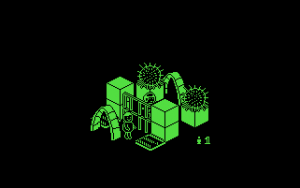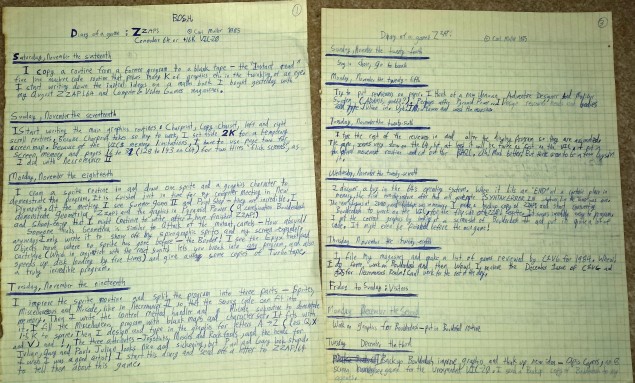Part 1: 1980s Home Brew – The Beginnings A three part special where NZ designer Carl Muller shares his remembrance of home coding

[ 1 comment ]
In Part 1 Carl tells us about where he first encountered computers as a child in Fiji and how he created his first games (and made his first sale) typing listings onto the display machines at his New Zealand home town’s computer shop.
These are some of my memories of the golden early games of computer and video games, when it seemed I had so much free time.
Dreams of travel
In the early 1980s I was growing up in the tropical heat of Fiji. One category of businesses that often had both glossy reading material and air-conditioning were travel agencies. On my time off from school, I would go into travel agencies and airline offices to cool-down, look at the plane models, read the brochures, and dream of becoming a travel agent and making peoples’ dreams come true. Spending time there, I noticed the glowing green screens that the agents used, containing cryptic columns of text and numbers. I was entranced and wanted to find out more. In 1982 at the age of 12 I was sent to the posh school my mother taught at and I found out that you could make those screens do what you asked them to, if you did so correctly. My future path changed dramatically.
Early Steps
My maths teacher in 1982 was Dr. Richard Wah, now the Chairman of the Fiji Higher Education Commission, but then an inspiring maths teacher who took charge of one of the “Class X” after-school optional subjects, Computing.
We had two Commodore Business Machines computers: a 4016 and a 4032, named because they could display 40 columns of text and had 16Kbytes and 32Kbytes of RAM, not that we ever got close to using it all. They loaded programs (slowly) from cassette tape and had built-in monochrome monitors. We could program them in BASIC, saving our programs to our own cassette tapes. I think the first program I was shown looked something like this:
10 LET A=2
20 LET B=3
30 LET C=A+B
40 PRINT C
50 END
We could RUN this program and the computer would display the number 5.
This is a bit verbose even for the BASIC of the time, but gave us the general idea that you could tell computer what to do by writing a recipe of instructions.
As a historical note, this implementation of BASIC was partially written by Bill Gates himself, in the 1970s.
I would finish my maths classes early and ask to get more computer time, writing simple games in BASIC on the green screen monitors. At weekends I started spending time in computer showrooms instead of travel agencies, asking the staff to let me “play on the computer” – for example Commodore machines or a TRS-80. Some of those places did get tired of me doing that of course.
I would write games in which you controlled the letter O on screen, and enemies would be asterisks and chase you until they got you.
Arcades
At this time arcade machines were very popular, being located both in down-town shopping centres and in local shops. Ones I remember seeing include the monochrome vector graphics based “Asteroids”, the life-threatening “Balloon Bomber” and “Defender” (in the sense that I nearly choked at a barbecue, hurrying to watch someone else playing the games), the watch-out-for-the-cold-war “Missile Command” and “Polaris”, the wonderful dual-joystick “Crazy Climber”, and the catchy-tuned “New Rally-X” which I (much later) worked on professionally. The games we now think of as the biggest names, “Pac-man” and “Space Invaders”, had less of an impact on me at the time, although I appreciate Pac-man much more now that I have looked deeper into its elegant logic, and coincidentally written conversions that sold millions of copies in the 2000s.
Type-in Magazines
One of my uncles in New Zealand sent me two pages torn out of the British magazine “Computer and Video Games” August 1982 which contained the program “Rocks”, a clone of “Asteroids” for the Commodore VIC-20. I went to a down-town computer shop and typed the whole program in. When I ran it the program self-destructed! Fortunately, I had saved a copy of it to cassette tape before I tried running it otherwise what seemed like hours of typing would have been lost. I then looked at the instructions, and it required more RAM to be installed in the machine before running. After doing that, it ran fine. A customer at the shop came in and asked how much it was. After saving a copy to another tape the owner sold the game on the spot!
Type-in magazines and books were at the heart of the computer learning experience at the time. “Computer and Video Games” was available in local newsagents delayed by a few months. The United States had similar magazines such as “Compute’s Gazette” and “Ahoy!”. For the price of a week’s pocket money you could get a listing of games for a variety of the 8-bit computers popular at the time: Commodores PET, VIC-20, 64, ZX Spectrum, Oric 1 and Amstrad, Dragon 32, TRS 80, Acorn Electron and BBC-B. Fewer listings were for the Apple ][, since it was a bit pricey for the home user. By the time 16-bit computers like the Atari ST, Commodore Amiga and Sinclair QL came along, programs were too big to fit into listings magazines and the market moved on.


Ah, yes. The way to master the art of game design and coding was through repetitive listings of some of the great games kids would submit to magazines! I remember that well… 🙂
I even have a few of the games I typed in archived. I found the tapes last week and have managed to convert them pretty successfully – I played them, and to be honest, some of those basic games are actually pretty good!
If anybodies interested in playing some of those “typed in” games from way back in the early 80’s (they’re for ZX Spectrum) on an emulator, here’s the links… From memory, apart from some C90 and C60 cassettes that I can’t find these days, these probably the first 4 tapes I recorded (hence likely the few collection of games I typed in that I liked enough to keep) 😀
https://dl.dropboxusercontent.com/u/9174107/Fun_basic_games_1.zip
https://dl.dropboxusercontent.com/u/9174107/Fun_basic_games_2.zip
https://dl.dropboxusercontent.com/u/9174107/fun_basic_games_3.zip
https://dl.dropboxusercontent.com/u/9174107/Tape4_spraymania.tzx